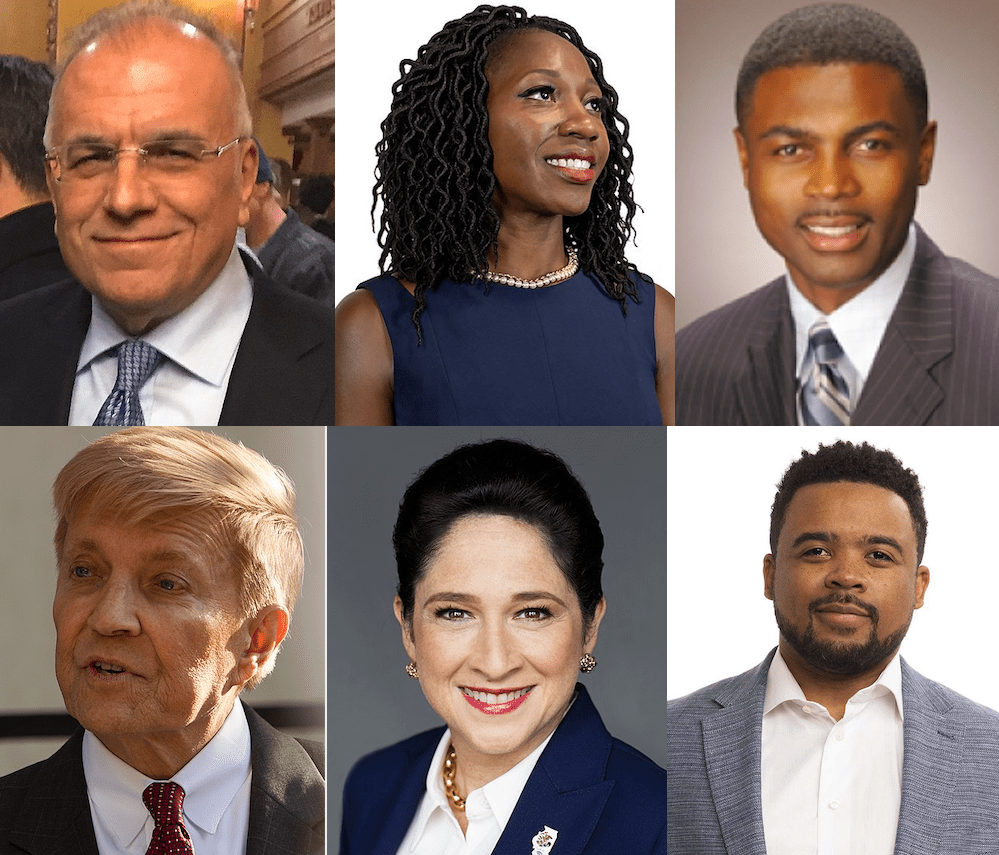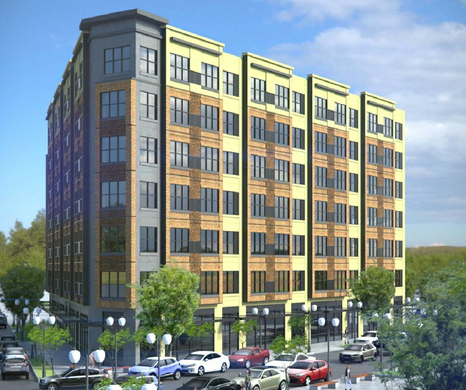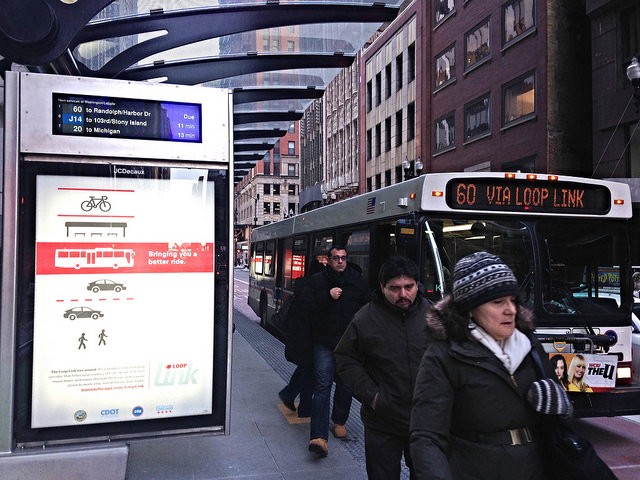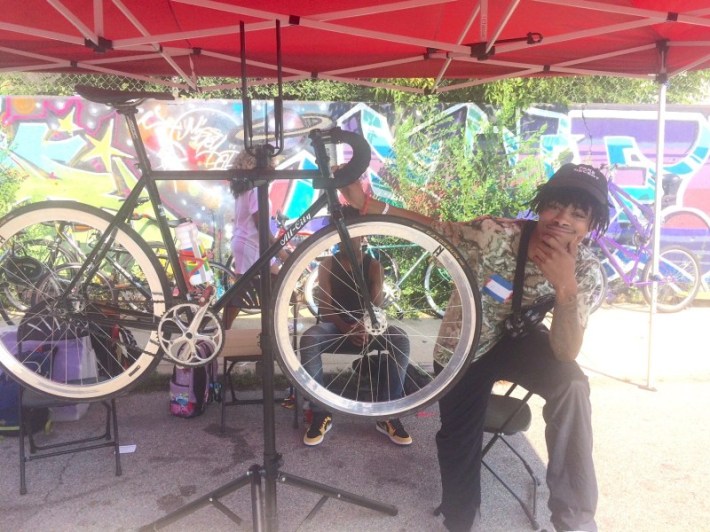Mayoral Candidates Discuss Congestion Pricing, Parking, Bike Ticketing and More
4:09 AM CST on February 23, 2019

Clockwise from top left: Chico, Enyia, Ford, Fioretti, Mendoza, Sáles-Griffin.
Streetsblog Chicago, the region’s sustainable transportation news and advocacy website, recently sent a questionnaire to all of the candidates in the Chicago mayoral election. Active Transportation Now and the Chicago Tribune have also surveyed the candidates about transportation issues, so we tried to include topics that weren’t previously covered, and push the envelope a bit by asking the mayoral hopefuls to weigh in on progressive ideas for increasing safety and mobility, and reducing congestion and pollution. The questions we sent, which originally included background info, have been abbreviated for this article.
We got responses from the campaigns of former Chicago Public Schools board president Gery Chico; Austin Chamber of Commerce director Amara Enyia; attorney and former alderman Bob Fioretti; state representative La Shawn K. Ford; Illinois comptroller Susana Mendoza; and tech entrepreneur Neal Sáles-Griffin. Here’s what they had to say.
Whether or not you believe Chicago’s “Vision Zero” goals of eliminating serious and fatal crashes in the next decade is realistic, how would you improve traffic safety?
The Chico campaign’s response focused on “smart traffic lights” to allow the Chicago Department of Transportation to “monitor, predict and respond to traffic demands and conditions with optimal signal timing. This system will not only intelligently route vehicles but also make pedestrian traffic safer, such as on Lake Shore Drive and Randolph Street.”
Enyia spoke of the need for “equitable and adequate distribution of resources for infrastructure, in particular for helping residents choose how they get around… Running a major department such as CDOT with a patchwork of funds exacerbates inequities in our city.” She argued that relying on aldermanic menu money to fund transportation infrastructure is “problematic.”
Ford stated, “We need to invest in modern day urban infrastructure that caters to all forms of transportation.” (However, when the Tribune asked him about installing more bike lanes he said, “That’s the last thing we should do.”)
The Fioretti campaign argued that the Vision Zero goal is “not realistic with current technology, but once we have widespread anti-collision mechanisms, and eventually self-driving vehicles, we’ll significantly reduce crashes… We won’t get to zero, but we can get way down to just a handful of crashes and fatalities every year.”
The Mendoza campaign called for creating dedicated infrastructure for different travel modes as a strategy to reduce traffic fatalities. “That means more bike lanes, bus lanes, and linear parks to give non-car transportation options the space they need to keep out of the way of vehicles.”
Sáles-Griffin said the city should continue to approach crashes as a public health issue and combat them in a holistic way that looks at all the causes. He emphasized the need for “complete streets” that prioritize the safety of pedestrians. “Peer cities across the country have demonstrated the effectiveness of public safety campaigns in improving traffic safety. We should learn from these examples.”
Do you support Rahm Emanuel’s proposal to raise the Illinois gas tax to fund infrastructure?
All of the participating campaigns say they’re opposed to this idea, except for Mendoza's, which didn’t comment on it.
The Chico campaign called raising the gas tax “a brick on the back of working-class families.”
Enyia cited various cost-cutting and revenue-generating strategies as alternatives for funding Chicago infrastructure, ranging from establishing a public bank, to expanding the small business sector, to minimizing police misconduct payouts.
Ford called for instead raising revenue through a “LaSalle Street tax” on financial transactions and a graduated state income tax.
Sáles-Griffin called a gas tax hike “a quick-fix strategy” and argued that “we should look for long-term revenue streams.”
Would you be open to exploring a London-style congestion tax on downtown driving to fund transit?
Sáles-Griffin expressed some interest in this strategy. “Congestion taxes have been shown to work in other cities, which is an important indicator. However, [any] unintended consequences (like travel inequities) as a result of implementing the tax must be mitigated. Any discussion of a congestion tax would require a holistic conversation around providing effective regional public transit, so travelers have an alternative when the congestion is highest.”
All of the other campaigns more-or-less rejected the idea, save for Mendoza's, which didn’t comment. The Chico, Enyia, and Ford campaigns argued that Chicagoans are overtaxed and/or the toll would be regressive; Fioretti said he would “probably not” support this approach.
What do you think eliminating zoned parking minimums for new construction in order to help reduce housing costs and congestion, as Minneapolis and San Francisco have recently done?
All of the campaigns either supported the idea of dropping the automatic minimums (in favor of letting developers, officials, and residents decide how much parking, if any, is appropriate), or expressed interest in studying it further, except for Mendoza's, which didn’t comment on it.
The Chico campaign expressed interest in studying how this approach has worked out in other cities and possibly revising the current parking requirement rules.
Enyia said she’d be open to exploring this strategy if it involved “a people-driven, bottom-up approach to determining what’s best for residents."
Fioretti’s campaign said the idea is “worth examining,” but expressed some reservations. “Bob supported [dense, parking-lite] transit-oriented development when he was on the Council, but now believes it isn’t working as well as it should: Even large apartment buildings that have few or no car owners are still swarmed with cars because of people taking Uber and Lyft... It would be good to have the population density needed to support neighborhood businesses without having the streets choked with cars, but with car ownership and car use now two different dynamics, it’s hard to say what mechanism will achieve that.”

Do you have any ideas to encourage affordable transit-oriented development in gentrifying and lower-income neighborhoods?
The Chico campaign said, “When new developments are built, there must be equal affordable housing and market value properties built together. This will bring about a community where people help one another. Recently, TOD has sped up gentrification of neighborhoods and we will need to make sure that future TOD doesn’t eliminate our current affordable housing.”
Enyia stated, “Chicago is a world-class city, which means you shouldn’t have to own a car to get around Chicago is also a leader in bankruptcies due in part to punitive and inequitable ticketing practices.” She said she is committed to an inclusive development plan, which includes improving transportation access, and promised to do an equity audit of all city departments, including the CTA, and “follow that with plans that center equity especially in how and where we invest in transportation and infrastructure.”
Fioretti's campaign said, “Most development, period, has been upscale buildings in affluent neighborhoods. We have a variety of ideas to spur development in economically forgotten areas, and using the availability of transit as a selling point is part of the plan.”
Ford stated, “I would not support any development project that would cause gentrification and displacement. I want all communities to be at the table and decide for themselves what will serve their best interests.”
Mendoza’s campaign said that increasing the availability of affordable housing near transit is one of her top priorities. “One of the strategies Susana will use to encourage [affordable] TODs, in both gentrifying and underserved neighborhoods, is seeking zoning changes that will encourage more density and fewer areas zoned for single-family homes.” Mendoza also supports expanding TOD zones to include areas near high-frequency bus routes. “This will disproportionately help increase transit access in underserved communities.”
Sáles-Griffin argued that we need to strengthen Chicago’s Affordable Requirements Ordinance by requiring developers to build on-site affordable units in new construction, including project near transit, not just paying into a fund to help build units elsewhere. He added that raising wages to fairly compensate workers “could organically attract and encourage the construction of transit-oriented development [in lower-income neighborhoods] based on the buying power of the community.”
Would you implement strategies to speed up bus service, such as prepaid, all-door boarding and car-free bus lanes?
Chico’s campaign replied, “Gery supports any measure that is proven to lower traffic congestion.”
Enyia said, “We need a full audit of CTA finances before we can develop specific policies to remedy issues of congestion and safety.” She added that she would seek new revenue sources for bus infrastructure. “For example, instead of directing ticket revenue into the general fund, I propose sending it directly to improve transit.”
Fioretti’s campaign responded, “Prepaid all-door boarding can work in certain locations where there is a high boarding count and the physical ability to create a pre-paid boarding area. Bob is not a fan of expanding car-free bus lanes at this time, seeing that the Loop Link lanes don’t do much to speed buses in the Loop, and seeing that the bus lanes on Jeffery Boulevard are frequently violated by cars, both in-motion and parked.” They recommended removing four-way stop signs on bus routes, or replacing them with synchronized stoplights, and said in some cases buses could be given a head start at traffic signals.
Ford didn’t directly address the question but stated that all public transit should be free, adding that revenue for this, as well as transit infrastructure projects could be generated by implementing progressive taxation and creating a public bank.
Mendoza’s campaign said she “would strongly support the implementation of tap-and-go payments or virtual ticketing for all buses as well as the expansion of bus lanes and [transit] signal prioritization.”
Sáles-Griffin voiced support for the timesaving strategies. “Buses provide very low-infrastructure ways to serve the public’s transit needs. I would work with city agencies and advocacy groups to sustain and increase bus ridership.”

Are you in favor of integrating CTA and Metra fares, including low-cost transfers?
All of the candidates supported this idea, or at least looking into it.
Enyia stated, “Our campaign would be interested in exploring the option. It would require collaborating with the various municipalities and residents impacted via a feasibility study and revenue allocation analysis.”
Fioretti’s campaign had some reservations. “Yes, it is fairer, but if it’s a net revenue loss, where will the money come from?”
Mendoza’s campaign said, “One of the key tenets of Susana’s transportation plan is creating a more unified transit system.”
Would you end the CPD’s stated practice of using zero-tolerance enforcement of bike infractions as a strategy to conduct searches in some communities of color?
Almost all of the campaigns condemned this policy and said they would end it, except for Fioretti’s who said more info was needed.
The Chico campaign stated, “Yes, we need to rebuild the trust between police and communities.”
Enyia said, “This stop and frisk strategy is immoral… Chicago’s legacy of draconian policing in low-income Black and Brown communities takes a significant toll on the pockets our communities… The majority of Chicago’s bike tickets go to bikers in Black communities like Austin and Lawndale.” She added that ticket-driven “perpetuates a cycle of financial insecurity for [people] that are already significantly disenfranchised.”
Fioretti’s campaign stated. “If it’s just harassment, then yes, the practice should be stopped. But if these actions are helping the cops pick up serious offenders, that’s good policing – as long as it doesn’t involve harassment of innocent people just because of their look or their location.”
The Mendoza campaign said, “Susana has pledged to launch a full top to bottom review of the city’s fines and penalties and how they’re enforced… Bicycle stops should not be used for the ulterior motive of stopping riders to conduct public safety searches. Susana will ensure that bicycle infractions are only being given for the purpose of increasing rider and vehicular safety.”
Sáles-Griffin said, “This, and other inequities in our policing needs to be made more transparent so we can tamp down on targeted police practices.”
If you agree that cycling has health, mobility, and economic benefits for people in lower-income neighborhoods, what would you do to encourage it in these areas?
The Chico campaign stated, “We need to increase access to bikes in low-income communities to encourage ridership.”
Enyia said, “There is a shortage of bike infrastructure on Chicago’s streets… Biking is a low-cost mode of transportation, especially compared to driving and it needs to be accessible to more people. On-street bikeways and protected bike lanes are part of the solution.” But she added “We can’t continue to plop down infrastructure without talking to people and providing the education and encouragement that will make these improvements successful.”
Fioretti’s campaign stated that he’s in favor of dockless bike-share as a first- and last-mile solution for transit trips. “Some people are just not going to be bike riders, though, especially in the winter.”
Ford stated, “The city should incentivize healthier and greener choices of transportation.”
Mendoza’s campaign stated, “Encouraging cycling begins with visibility and accessibility. Susana will work on a public education campaign that includes residents seeing her riding her own bike as well as leveraging other key influencers in the city to encourage cycling.” The added that she would expand access to bike-share.
Sáles-Griffin said “We should service these communities with greater access to bike lanes and partner with community organizations to educate residents on the ease of riding and tuning bikes, so this becomes a reliable mode of transit for them.”

Are you in favor of expanding Divvy to serve the entire city and, if so, how quickly would you do it, and how would you fund the expansion?
All of the campaigns expressed interest in expanding bike-share citywide (although no one gave specifics), with the notable exception of Fioretti’s.
His people stated, “Not sure Divvy is the future, especially in neighborhoods with less… density. We don’t want to expand the program just to say we did it. The dockless [bike-share] companies may be the way to go for areas where Divvy is not practical. We’ll have to see what works, and what the benefits and costs are.”
Would you allow point-to-point car-share, dockless bikes, and dockless scooters to be operated across the entire city?
Most of the campaigns expressed general support for allowing these shared-mobility options citywide.
Chico’s campaign said, “Yes, Gery would support these programs if they show an ability to help congestion and provide residents a safe way around the city.”
Fioretti’s people said, “Yes, though some regulations may be required.”
The Mendoza campaign stated, “Susana is interested in looking at a variety of last-mile transportation options to increase mobility throughout the city. That would include bike-share and e-scooters, as well as other new options that are currently being utilized in other cities. In many instances, these companies are ready to expand to cities like Chicago; they just need a fair and logical regulatory framework. Susana will work to create rules of the road to ensure that riders are safe, implementation happens throughout the city and access is distributed evenly.”
Sáles-Griffin voiced a bit of skepticism. “The impacts of their ridership need to be studied before I fully support this.”
In addition to editing Streetsblog Chicago, John writes about transportation and other topics for additional local publications. A Chicagoan since 1989, he enjoys exploring the city on foot, bike, bus, and 'L' train.
Stay in touch
Sign up for our free newsletter
More from Streetsblog Chicago
Johnson appoints one West Side pastor to CTA board, then nominates another West Side pastor for RTA board
Supporters argue that, despite his lack of transit expertise, Ira Acree’s social justice experience and political connections could be an asset for the RTA board.
Today’s Headlines for Thursday, April 26
The de-facto ban on riverwalk biking is back. What should we do about it?
In the short term, new signage is needed to designate legal areas for cycling on the path. In the long term CDOT should build the proposed Wacker Drive protected bike lane.


